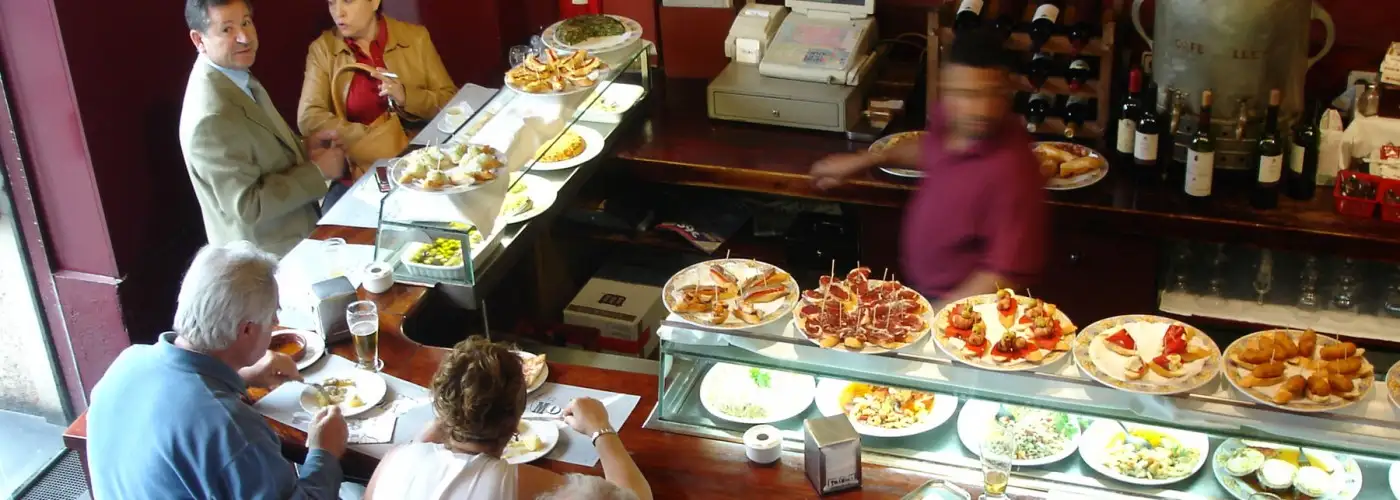One of the great joys of European travel is eating. If you let yourself tune in to the experience, a meal is a travel thrill in itself—as inspiring as visiting an art gallery and as stimulating as a good massage.
I have only a few basic rules for eating my way through Europe: Find places outside the tourist zones. Go for local specialties. Eat seasonally. Most of all, eat fearlessly, trying things you’ve never had in places you’ve never been.
Begin by looking for welcoming spots filled with locals. On a recent visit to France, I sat amid a crush of happy French diners in an atmospheric, wood-timbered restaurant. Glasses filled the room like crystal flowers; portraits of long-forgotten city fathers kept an eye on us from the walls.
I ordered top end, my travel partner took the basic menu, and as usual, we shared. To start, we treated ourselves to a dozen juicy escargots. I gently pried a snail out of its shell and popped it into my mouth. The taste was so striking that I found myself requesting silence at the table. It was just my mouth and the garlic-drenched snails, all alone on the dance floor of my palate.
Especially in countries with noteworthy cuisines, I recommend an occasional gourmet splurge like my meal in France. But all across Europe there are eating options to fit every budget and taste. And now that most interiors in Europe are essentially smoke-free, you can breathe while you eat.
Most restaurants have a well-priced menu of the day—offering a choice of appetizer, entrée, and dessert at a fixed amount. These menus aren’t just for tourists; savvy local diners are quick to order the daily special. If you aren’t sure what to choose, take a minute before you order to observe what’s being served on the tables around you.
I like to stretch my budget (and conserve my waistline) by sharing dishes. Don’t be intimidated by a menu listing multiple courses—you’re not expected to order one of each. A good rule of thumb is for each person to order any two courses. For example, two people can order and share one appetizer, one pasta dish, one fish dish, and one dessert—or choose two appetizers and two pastas—or whatever combination appeals.
Wherever you dine, you’ll eat better if you understand the basic menu terms. A phrase book can help you get trota (trout) instead of tripa (innards) in Italy, and ostras (oysters) instead of orejas (pigs’ ears) in Spain.
Adapt to the culture you’re visiting. In most European restaurants, dining is not rushed, and the table is yours for the entire evening. The waiter or waitress is there to serve you, but will remain in the background. Out of courtesy, you won’t be presented with the bill until you ask for it.
Many sit-down restaurants take the mystery out of tipping by including a service charge in the bill. Study the menu for words like “service compris” or “servizio incluso.” An additional tip is not expected in these cases, but if you liked the service, simply round up the bill a bit (if your check is €18.80, leave €20). This varies from country to country, so get advice from locals.
If you’re looking for a quick bite, you have plenty of options—every country in Europe has its own cheap and delicious street food. In Greece, try the corner souvlaki stand. For fast food Istanbul style, grab a fishwich at the waterfront, fresh from the guys who caught it. Order up a razor-thin crepe from a street vendor in Paris, and then choose a filling to make it savory or sweet.
If you’d rather take a seat while you eat, there are lots of casual bars and bistros. Eating at a corner cafe costs only a little more than lunch at a fast-food joint, but you’ll be chowing down on local fare that’s typical of the region.
One of the best examples of this is in Spain. Every town tempts you with tapas bars, where you belly up to the bar and just point at appetizers you’d like to try. In Denmark, I love the traditional open-faced sandwiches, with simple toppings elegantly perched on a slice of bread. In Bavaria, there’s nothing more local than a knuckle of pork, spiral-cut radishes, sauerkraut, and a huge pretzel.
When I’m enjoying a delicious meal, I always appreciate hearing the quiet murmurs of other diners around me. It lets me know that I’m among likeminded souls who treat eating as bliss. Communing with others over good food, served in a setting respectful of tradition and place, is cultural tourism at its tastiest.
Rick Steves (www.ricksteves.com) writes European travel guidebooks and hosts travel shows on public television and public radio. Email him at rick@ricksteves.com and follow his blog on Facebook.
(Photo: Rick Steves)You Might Also Like:
We hand-pick everything we recommend and select items through testing and reviews. Some products are sent to us free of charge with no incentive to offer a favorable review. We offer our unbiased opinions and do not accept compensation to review products. All items are in stock and prices are accurate at the time of publication. If you buy something through our links, we may earn a commission.
Top Fares From Columbus, OH
Today's Top Travel Deals
Brought to you by ShermansTravel
Shop and Save with Country Inns...
Patricia Magaña
 Hotel & Lodging Deals
Hotel & Lodging Deals
$229 -- Chicago: Discounted Rates and...
Francesca Miele
 Hotel & Lodging Deals
$229+
Hotel & Lodging Deals
$229+
$188 -- Honolulu: Save on Oceanview...
Abigail Lamay
 Hotel & Lodging Deals
$188+
Hotel & Lodging Deals
$188+




